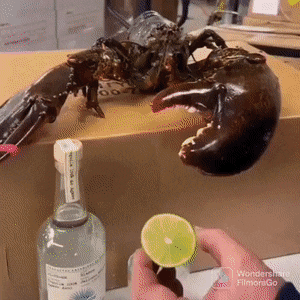Text
85K notes
·
View notes
Text
Daily fish fact #509
Amazon molly!

This species is 100% female (something that their common name references), and it reproduces through gynogenesis! This is essentially parthenogenesis, but the eggs of the fish must be stimulated by the presence of sperm — however, the sperm does not actually fertilise the eggs and contributes no genetic material to the offspring.
562 notes
·
View notes
Photo


The Department of Fisheries in Hyderabad, India, is shaped like a fish.
117K notes
·
View notes
Photo
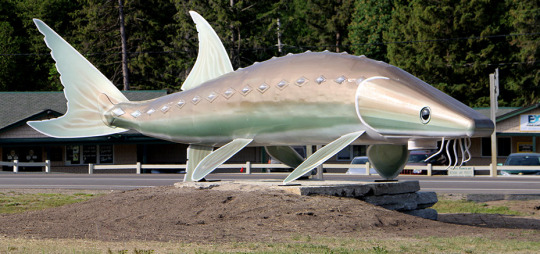
here is our local sturgeon sculpture. he is shaped like a friend and i love him :)
40K notes
·
View notes
Photo
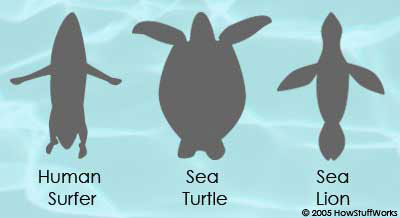

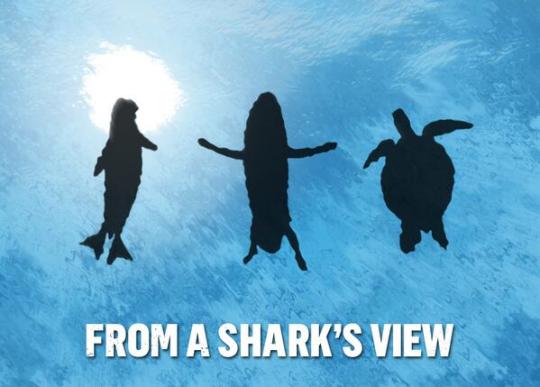



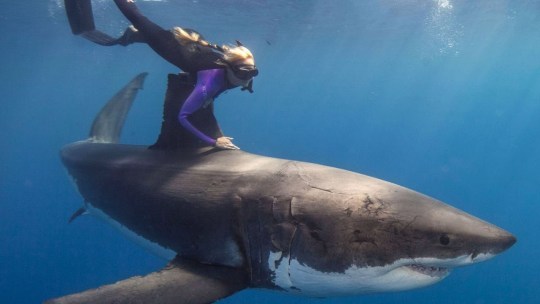
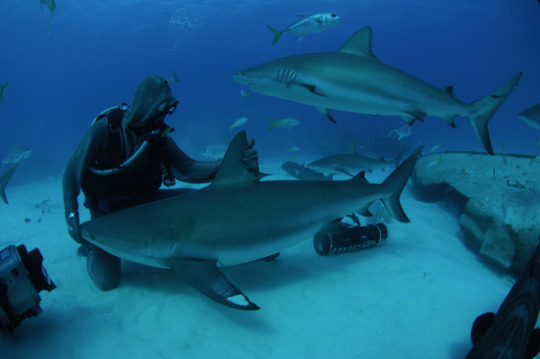
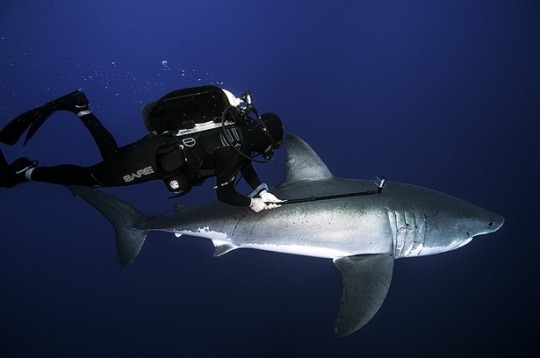
🌊🏊Sharks are nice!🏄
Since its summertime and people are gonna be hitting the beach to swim and/or surf, i decided to make this informative shark post.
In the media sharks are portrayed as mean bloodthirsty and vicious creatures. Such as in movies like “The Shallows” and “Jaws”. But are sharks really that vicious? The answer is no. No they are not. Sharks are really nice and sweet creatures. I am a surfer and have been bitten a couple of times by sharks but i still know the truth… sharks aren’t evil creatures.
You may be thinking “but you’ve been bitten by one! How can they not be evil!?” Well the answer to that my bro
is simple, its all a misunderstanding. You see, sharks dont have great eyesight. They are blind as fuck. So they rely on other senses to find food. They see the silhouette of us surfers on our boards and they see it from a below angle and they think we kind look like seals, their favourite meal (as seen in the pics above). So they take just a nibble to see what the fuck we are. Once they realize we aint a seal, they go away. Why? Sharks HATE the taste of human meat. We disgusting af to them. Thats why the majority of shark attacks are just sharks bitting once and then leaving. They just wanted to know what the fuck we are bro. Its a case of mistaken identity. A misunderstanding. Have there been shark attacks where the shark bites more than once? Yeah. But thats rare and it only happens if the shark is either
(1) feeling threatened or provoked.
Or
(2) very hungry. Like, i mean STARVING.
Sharks just wanna eat but they dont wanna eat us. Its just a simple misunderstanding. As you can see in the photos above, people can swim with sharks and nothing happens. Its totally fine my dudes. So there you have it, sharks are homies, not hostile.
Sources:
Jaws- https://en.m.wikipedia.org/wiki/Jaws_(film)
The Shallows- https://en.m.wikipedia.org/wiki/The_Shallows_(film)
http://adventure.howstuffworks.com/shark-attack.htm
MORE INFO:
The likelihood of being attacked by a shark is thought to be 1 in 11.5 million, and only 4 or 5 people in the entire world die each year from shark attacks.[1]. If you’re still nervous about meeting one of these ocean predators, check out these guidelines to help you further minimize the chances of an encounter- http://m.wikihow.com/Avoid-Sharks-While-Surfing
PLEASE REBLOG THANKS MATE
174K notes
·
View notes
Note
so, like, what do you think about chihuahuas???
They are a lovely and very underrated fish
41K notes
·
View notes
Text

HEY EVERYONE AMAZING GROUND BREAKING NEWS FROM THE WORLD OF SCIENCE!
AFTER MANY HARROWING YEARS….
🎉💥✨WE FINALLY KNOW HOW EELS FUCK✨💥🎉
12K notes
·
View notes
Text
Whenever I see a picture or a video of moon sea jellies I have to stop whatever I am doing and count the gonads (circle things on their bell) they all have because I know that most sea jellies are suppose to have 4 but sometimes will have fewer or more due to mutation and I like spotting the ones that have an abnormal amout of testies

6K notes
·
View notes
Text
Welcome to a topsy-turvy Wet Beast Wednesday where I'm discussing one of my favorite cnidarians, the upside-down jellyfish. These are 8 species of jellyfish in the genus Cassiopea, which is the only member of the family Cassiopeidae. What makes these jellies notable is the fact that they spend most of their time lying upside-down on the seafloor.

(image: an upside-down jellyfish swimming. It has a light brown and white striped bell and multiple tentacles that are tuck and white. The tentacles branch and are lined with feathery, light brown structures)
While the majority of jellyfish are predators who drift through the water at the mercy of the currents, upside-down jellyfish have essentially become farmers. Their eight branched oral arms that contain symbiotic algae called zooxanthellae. These algae are photosynthetic and live in a mutualistic relationship with the jellyfish. The jellyfish gets food from the zooxanthellae and they get protection from predators and a place to live. Upside-down jellyfish can survive entirely on the nutrients produced by the zooxanthellae, but they will still feed on zooplankton and other small prey. Upside-down jellies are not the only jellyfish to utilize zooxanthellae, many other species also survive primarily on their symbiotic algae, but they are the only ones to have adapted the benthic lifestyle. They can reach a bell diameter of up to 25 cm (10 inches), or as one source for this stated: about the size of a pie pan.
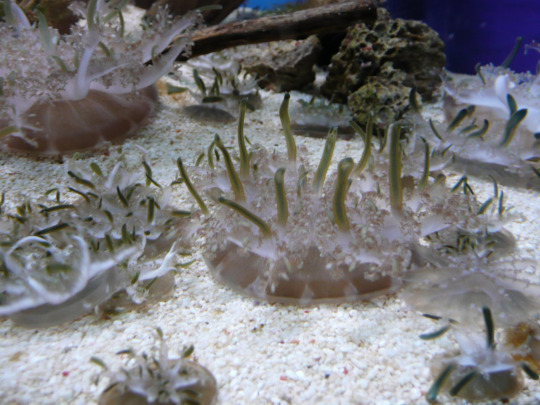
(image: multiple upside-down jellyfish lying on sand. They are ov various sizes and mostly light brown, but have thicker, green tentacles sticking op)
Upside-down jellyfish are found in warm coastal waters in Florida and the Caribbean and in Micronesia, Melanesia, and parts of Polynesia. They require shallow waters to allow enough light to reach their zooxanthellae and are usually found on shady or muddy bottoms. They are highly associated with mangroves and may play an important role in the mangrove habitats by mixing the water to recirculate oxygen and nutrients. They are rarely found alone, instead congregating in large groups that can cover portions of the seafloor. They attach by using their bells as suction cups and rhythmically pulse using the edges of the bell. This pulsing forces water over the gills and can force zooplankton into the stinging cells to become food. Stung prey will fall on the oral tentacles, where it is broken down into fragments that are then intaken through the numerous tiny oral openings on the tentacles. Interestingly, some species have cycles of reduced movement, which is believed to be the first known example of sleep in an animal without a central nervous system. While upside-down jellies can swim, they will usually only do so to escape predators or if their environment becomes unsuitable.
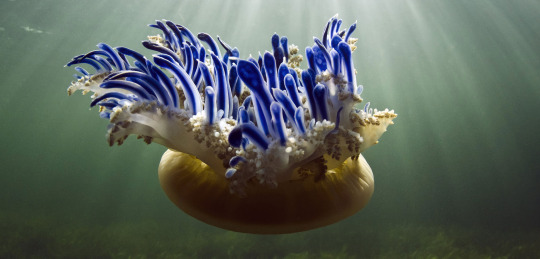
(image: an upside-down jellyfish swimming. The majority of its body is light brown, but it has many tentacles that are dark blue and outlined in white)
While a very neat thing to see underwater, many snorkelers avoid upside-down jellyfish due to a phenomenon called stinging water. This is when people will receive the symptoms of a sting by the jellyfish without actually touching it. While the cause of this was a mystery for a long time, it was solved when a 2020 paper was published in Communications Biology by Ames et al. The scientists discovered that upside-down jellies release clumps of mucus into the water. This mucus is filled with zooxanthellae and stinging cells and many of these clumps also have ciliated cells that allow for limited swimming. These clumps, named cassiosomes, are the source of the stinging water. The paper, titled "cassiosomes are stinging-cell structures in the mucus of the upside-down jellyfish Cassiopea xamachana" speculated that the cassiosomes are used for defense and feeding. The cassiosomes could be released to sting a potential predator from a distance, discouraging it from approaching the jellyfish. Presumably snorkelers trigger this defense when they swim over the jellies, resulting in stinging water. They could also be used to catch prey as zooplankton killed by the stinging cells would have a high likelihood of falling onto the jelly that released them. Because the cassiosomes have zooanthellae in them, they could survive for likely up to several days after release.

(image: a microscope image of three cassiosomes. They are irregularly-shaped blobs somewhat similar to popcorn. They are a dark color with grey outlines. Spots of green algae and white stinging cells dot their surface)
Upside-down jellyfish are threatened by habitat loss as many mangrove forests are torn down for development. They are also threatened by pollution. They are not considered dangerous to humans. The sting of an upside-down jellyfish can result in mild to severe rashes and itching, but is not lethal.
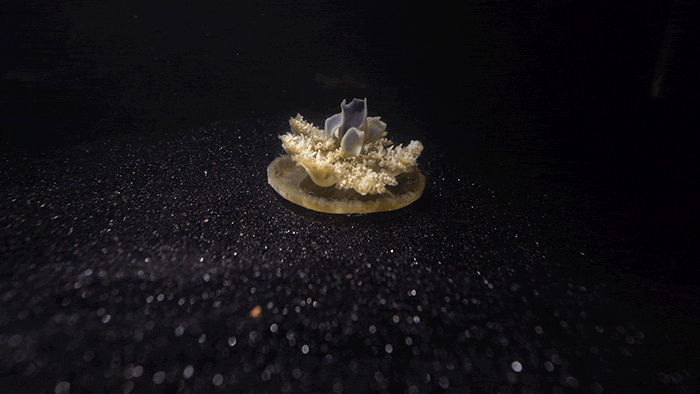
(gif: a lone, light brown upside-down jellyfish on black sediment. The edge of its flat, circular bell regularly pulse upward to move air over its gills and tentacles. This one's pulsing has slowed, which is speculated to be the result of it going through its sleep cycle)
834 notes
·
View notes
Text
1K notes
·
View notes
Note
i put you in tje pacific ocean
whadda hell.....,. fish in here.
13K notes
·
View notes
